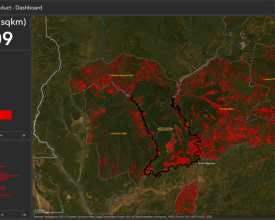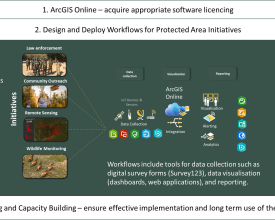
Aplicación de la solución de gestión de áreas protegidas de ArcGIS para el seguimiento holístico del paisaje en el ecosistema de Lunga Occidental, Zambia.

Las áreas protegidas se enfrentan a numerosos retos ecológicos, sociales y económicos tanto dentro como fuera de sus límites. La mayoría de estos desafíos se producen en vastas escalas espaciales y a menudo se ven magnificados por la falta de recursos para supervisar y responder adecuadamente a los desafíos. La Solución para Áreas Protegidas (PAM) de ArcGIS es una forma eficaz de abordar estos retos de forma holística y a escala. PAM permite a los usuarios configurar rápidamente varios flujos de trabajo para una gestión eficaz de las áreas.
M.A.P Scientific Services implantó PAM para el Proyecto de Conservación de West Lunga (WLCP) en el Parque Nacional de West Lunga, Zambia. La solución se centró en los flujos de trabajo que mejoran la supervisión de la zona, como la teledetección de la deforestación y los incendios forestales, la aplicación de la ley, los avistamientos de animales salvajes y la divulgación comunitaria. Los resultados han permitido mejorar el seguimiento y la gestión basada en pruebas del área protegida, lo que beneficia a la conservación y a las comunidades cuyos medios de vida dependen intrínsecamente del ecosistema de West Lunga y sus servicios.
Contexto
Défis à relever
El ecosistema de Lunga Occidental es vasto y remoto, y está formado por el Parque Nacional de Lunga Occidental, las zonas de gestión cinegética circundantes y tierras tradicionales que ocupan una superficie de unos 11 754 km2. El objetivo a largo plazo del WLCP es hacer que este paisaje sea sostenible desde el punto de vista ecológico, social y financiero.
Entre las amenazas al ecosistema figuran la pérdida de fauna y flora debida a la invasión humana, las prácticas agrícolas insostenibles, la caza furtiva y los incendios forestales. Para mitigar estas amenazas, el WLCP ha apoyado al Departamento de Parques Nacionales y Vida Silvestre para que aumente su capacidad de hacer cumplir la ley y pone en marcha iniciativas comunitarias locales para proporcionar medios de vida alternativos que mejoren la sostenibilidad a largo plazo de la zona. Uno de los principales retos era supervisar eficazmente estas intervenciones a escala para tomar decisiones de gestión informadas que aprovecharan sus limitados recursos.
Para ello fue necesario supervisar
- Cumplimiento de la ley.
- Avistamientos de fauna salvaje.
- Conflictos entre personas y animales salvajes.
- Iniciativas de divulgación comunitaria.
- Deforestación e incendios forestales.
Ubicación
Procesar
Resumen del proceso
Las soluciones y flujos de trabajo de gestión de áreas protegidas requieren ArcGIS Online. Como organización que trabaja en un área protegida, se puede solicitar ArcGIS Online a través del Programa de Conservación de Esri. ArcGIS Online proporciona un marco seguro y flexible para apoyar holísticamente los flujos de trabajo de recopilación de datos, visualización y elaboración de informes relacionados con las iniciativas de áreas protegidas. Los flujos de trabajo preconfigurados pueden desplegarse inmediatamente, o pueden diseñarse y desplegarse nuevos flujos de trabajo en ArcGIS Online. Para garantizar una implantación eficaz y un uso a largo plazo de la solución, se requiere formación y apoyo continuos durante todo el uso de la solución.
Bloques de construcción
ArcGIS en línea
La solución de gestión de áreas protegidas y los flujos de trabajo se construyen utilizando ArcGIS Online como base. ArcGIS Online es una solución de cartografía y análisis basada en la nube. Ofrece a los usuarios acceso a aplicaciones, mapas y datos específicos de flujos de trabajo de todo el mundo, así como herramientas para la movilidad sobre el terreno. Los usuarios pueden utilizarlo para hacer mapas, analizar datos y compartir y colaborar. Sus datos y mapas se almacenan en una infraestructura segura y privada y pueden configurarse para satisfacer sus necesidades cartográficas y de TI.
Factores facilitadores
- Las organizaciones pueden solicitar acceso a bajo coste a ArcGIS Online a través del Programa de Conservación de Esri rellenando la solicitud de asistencia tecnológica. Alternativamente, se pueden adquirir licencias a través de un distribuidor local de Esri.
- ArcGIS Online es una oferta de software como servicio (SaaS) basada en la nube que requiere conexión a Internet. Sin embargo, las herramientas están diseñadas para funcionar sin conexión por defecto. Una vez descargadas las encuestas, los datos capturados se guardarán en el dispositivo para poder sincronizarlos posteriormente.
Lección aprendida
- ArcGIS Online le permite crear un gran destino central para todos los datos de seguimiento de su organización.
- Si no está familiarizado con los SIG, la configuración de ArcGIS Online puede resultar desalentadora.
- Existen numerosos recursos para aprender sobre ArcGIS Online, utilícelos, especialmente la formación gratuita de Esri.
- Gran Foro de la Comunidad Esri para ArcGIS Online donde puede publicar preguntas.
- Hay varios tipos de usuario disponibles en función de las necesidades y requisitos de los miembros. El tipo de usuario determina los privilegios que se pueden conceder al miembro. Es importante conocer bien cuáles y cuántos tipos de usuario necesita su organización.
- Organice a sus miembros en grupos bien definidos para organizar las actividades y el acceso a los datos.
Diseño e implantación de flujos de trabajo
ArcGIS Online proporciona un marco seguro y flexible tanto para desplegar aplicaciones útiles como para integrar otras tecnologías de conservación con el fin de apoyar de forma holística los flujos de trabajo relacionados con cada iniciativa que esté llevando a cabo un área protegida. La base de todos los flujos de trabajo incluye herramientas para la recopilación de datos, como formularios de encuestas móviles (Survey123), visualización de datos (cuadros de mando o aplicaciones web), análisis e informes. Además, el ArcGIS Living Atlas of the World le da acceso a la principal colección de información geográfica de todo el mundo para apoyar sus flujos de trabajo, lo que incluye las últimas imágenes de satélite y productos como la pérdida de bosques.
Hay varios flujos de trabajo preconfigurados para iniciativas que se pueden desempaquetar y aplicar inmediatamente. Estas iniciativas incluyen:
- Seguimiento de la actividad ilegal.
- Supervisar la vida salvaje.
- Mitigar conflictos con la fauna.
- Mantenimiento de la infraestructura del parque.
Los flujos de trabajo son configurables y permiten a los usuarios personalizarlos en función de sus necesidades. Alternativamente, las organizaciones tienen acceso a todos los componentes necesarios para desarrollar flujos de trabajo completamente nuevos para sus propias iniciativas, por ejemplo, iniciativas de divulgación comunitaria o de participación pública.
Factores facilitadores
- Escuche a los profesionales de primera línea y colabore con ellos para comprender el problema y definir los requisitos antes de diseñar e implantar el flujo de trabajo.
- Hay varias aplicaciones configurables disponibles en ArcGIS Online, entender cómo funcionan y cómo pueden vincularse entre sí es crucial para desarrollar flujos de trabajo eficaces.
Lección aprendida
- Siga la estrategia de diseño, implantación, funcionamiento y revisión para desarrollar un flujo de trabajo y maximizar su impacto.
- Cree prototipos y pruébelos antes de implantarlos.
- Establezca procedimientos y directrices esenciales.
- Siga las mejores prácticas y tendencias.
- La experiencia en ArcGIS es muy beneficiosa; si no, recurra a socios de implantación para que el proceso sea más fácil y eficaz.
- Aproveche la comunidad ArcGIS y los recursos de formación en línea.
Recursos
Formación y capacitación
La formación del personal es importante para garantizar la implantación eficaz y el éxito a largo plazo de la solución. Dé prioridad a la formación durante la fase de diseño y despliegue, así como después del despliegue para garantizar el uso continuado de la solución.
Factores facilitadores
- Los responsables técnicos o campeones que impulsen la formación y el uso sobre el terreno mejoran las posibilidades de éxito.
Lección aprendida
- Utilice las herramientas de elaboración de informes de la organización para hacer un seguimiento de la participación y el uso de los usuarios y determinar cuándo y si no están utilizando las aplicaciones según lo previsto. Identifique por qué puede haber un problema y colabore con ellos para solucionarlo.
- Las barreras lingüísticas pueden ser un problema y los formularios deben ser sencillos para que la recogida de datos sea eficaz.
- La formación no debe considerarse un ejercicio aislado, sino un proceso continuo.
- La rotación de personal es una realidad y las organizaciones deben garantizar la continuidad contando siempre con más de un miembro senior del personal formado en los distintos flujos de trabajo y la administración de ArcGIS Online.
- Los socios de implantación pueden hacer que la formación y el soporte a largo plazo de la solución sean más manejables.
Impactos
Se digitalizaron ocho flujos de trabajo basados en papel y se implantó un flujo de trabajo de teledetección destinado a mejorar los procesos de recopilación de datos y optimizar las iniciativas clave.
Hasta la fecha
- ~Se ha formado a unos 25 usuarios en el uso de aplicaciones móviles personalizadas para registrar
- Detalles sobre cada patrulla de las fuerzas de seguridad y cualquier incidente que se produzca durante la patrulla, por ejemplo, caza furtiva, captura con trampas, tala o indicios de actividad ilegal.
- Avistamientos de fauna salvaje.
- Programas de divulgación comunitaria, por ejemplo, la ubicación de los agricultores y sus colmenas para mejorar la eficacia de las iniciativas de divulgación comunitaria dirigidas a métodos alternativos de apoyo a los medios de subsistencia.
- Se han realizado ~180 patrullas utilizando la solución.
- Se han registrado ~300 incidentes de patrulla.
- Se han realizado dos recuentos completos de fauna silvestre sobre el terreno utilizando la solución.
- Se han registrado ~850 avistamientos de fauna silvestre de 40 especies.
- Se ha registrado la ubicación de ~8 000 colmenas en el ecosistema.
- Se ha cartografiado la ubicación y extensión de ~15 000 incendios.
En una única plataforma segura, la dirección del parque, el personal y sus socios pueden hacer un seguimiento eficaz de la recogida de datos y evaluar sus iniciativas de gestión casi en tiempo real, obteniendo información basada en pruebas sobre dónde se producen los incidentes, cómo cambian las poblaciones de fauna salvaje, si las iniciativas comunitarias tienen éxito y qué zonas son vulnerables a la sobreexplotación, la recolección ilegal y los incendios forestales.
Beneficiarios
Los beneficiarios son el ecosistema de Lunga Occidental, el personal y los gestores del área protegida, y las comunidades que rodean y viven en el ecosistema de Lunga Occidental.










